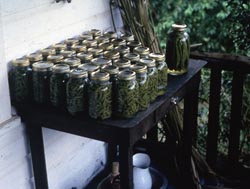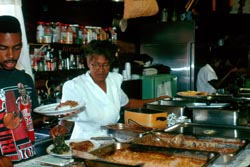North Louisiana Folklife Traditions and Research: An Overview
By Susan Roach
Often people unfamiliar with Louisiana stereotypically consider the whole state to be made up of French-speaking Cajuns, Catholics, and swamps; however, this misconception overlooks the fact that Louisiana is divided geographically, ethnically, and philosophically into two regions. Predominantly Protestant, North Louisiana is culturally part of the upland and riverine U. S. South. Scholars have suggested a number of boundaries between south and North Louisiana, using various mappable cultural traits such as French/English differences, Catholic/Protestant religious differences, liberal/conservative voting preferences, and differences in material culture such as housing. This boundary begins in the southwest corner of the state, where the Sabine River empties into the Gulf, and runs northeast to the point where the thirty-first parallel crosses the Mississippi (in northern Avoyelles Parish) and then runs southeast through the mouth of the Mississippi.
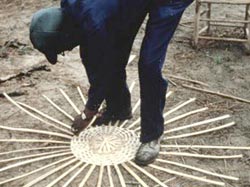
North Louisiana's mainly rural folk landscape was shaped by contacts among Indians, Anglo- and African Americans, in pioneer, plantation, sharecropping, and small farm settings in the river bottomlands, piney woods, and hills of the region. In addition, other cultural groups in the area include Creoles of color in the Cane River area below Natchitoches, Spanish-speaking people of partial Choctaw descent who live on the Texas/Louisiana border, and Italians, Hungarians, Czechs, and others. Scholars have likened the area to a strip quilt made up of many separate, textured pieces.
Interestingly, while many people think that the northern region of the state is not culturally important, in actuality, research is finding it to be the most traditional part of the state. Since the establishment of the Louisiana Folklife Program in the Louisiana Division of the Arts in 1978, projects focusing on folk traditions in North Louisiana reveal viable traditions ranging from music such as old-time country fiddling, blues, and gospel; to crafts such as white-oak basketry, quilting, and hoop net-making; to foodways such as cooking cornbread and butterbeans, canning mayhaw jelly, and curing pork.
Research by folklorists on these folk traditions in different areas of North Louisiana has resulted in exhibitions, record albums, festivals, and publications. Scholars often see these attempts at identifying, preserving, and presenting folk traditions as cultural intervention because these projects not only conserve such traditions but also, in turn, may influence those very traditions which they have documented.
In recent years agencies and scholars on both the regional and state levels have been working to provide documentation of North Louisiana folk culture. The longest running has been the Louisiana Folklife Center at Northwestern State University in Natchitoches. Under the direction of Donald Hatley, the center conducted and archived research on the northern part of the state and has presented the results of this research at the popular Natchitoches Folk Festival held annually the second weekend in July since 1980. The center has jointly produced a Saturday night radio program on Louisiana folk music with national public radio affiliate KDAQ in Shreveport. The Folklife Center has also jointly produced several records with documentary notes with the Louisiana Folklife Program. The first, Cornbread for Your Husband and Biscuits for Your Man": Mr. Clifford Blake Calls the Cotton Press, (1980) provides rare documentation of the black traditions of press calls, blues, gospel, and animal and slave tales performed by Natchitoches Paris-born Blake, who subsequently was featured in state and national festivals and the CBS Evening News. The center's second record, The North Louisiana String Band, features the British American tradition of old-time country string band music with fiddle, guitar, mandolin, bass, and vocals. By putting the state program in touch with bandleader Troy DeRamus, who was the producer of the Louisiana Fiddling Championship at Boyce, La., this project also laid the foundation for the transfer of the fiddling contest to the Office of State Parks, which has also brought together more north and South Louisiana fiddlers and stimulated more interest in fiddling. The Center's third jointly-produced record, Since Ol' Gabriel's Time: Hezekiah and the Houserockers, provided important documentation of the rich delta blues tradition. The richness and importance of this music was an impetus for more research being conducted by Susan Roach and H. F. Gregory for the Louisiana Folklife Program in the Delta, the regional label for the northern parishes along the Mississippi River.
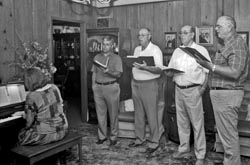
In addition to the Delta Folklife Survey in progress, there have been surveys and exhibitions devoted to traditions and other sub-regions in North Louisiana. The first exclusively North Louisiana research and exhibition of folk crafts, Doing It Right and Passing It On: North Louisiana Folk Crafts (1981), was produced by H. F. Gregory for the Alexandria Museum. After this exhibit, many of these artifacts were installed in the La. state Capitol permanent exhibit, The Creole State: An Exhibit of Louisiana Folklife. The North Central Louisiana Folklife Project, directed by Susan Roach, surveyed the folk traditions in a five-parish area know as the "Piney Hills" and presented these traditions in a regional festival, an exhibition, and a publication Gifts from the Hills (1984). This research reveals a continuity of rural regional traditions including folk architecture, farming and animal husbandry, farm and domestic crafts, foodways, verbal arts and oral history, secular music, and religious and family rituals and performances. These areas are also the subject of research done in the Florida Parishes Folklife Survey, directed by Joel Gardner. Although the northeastern Florida Parishes are south of the thirty-first parallel, research shows this area have more in common with the northern area of the state both geographically and culturally and can be considered part of North Louisiana. Both the folk festival held in the Hammond and the folklife exhibition at the Cultural Center illustrate the continuity of traditions between the Florida parishes and the rest of North Louisiana.
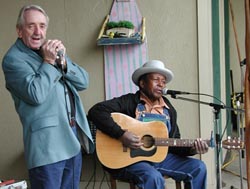
By presenting folk artists located through research, such festivals which focus on Louisiana folklife are important in spotlighting area traditions. Perhaps the longest running festival, the Louisiana Art and Folk Festival in Columbia has a folk component along with contemporary arts and historical revival crafts as does the Catahoula Lake Heritage Festival in Pineville. Other North Louisiana festivals also mix a few folk artists with revivalist and contemporary artists. While the Louisiana Folklife Pavilion at the 1984 Louisiana World Exposition in New Orleans, known as the World's Fair, featured folk traditions from the whole state on a small scale, the 1985 Festival of American Folklife for the first time featured extensive traditions from both north and South Louisiana in a festival format. In the years following, the Louisiana Folklife Festival, sponsored by the Louisiana Folklife Program, has continued this practice.
While such festivals are annual events, other projects featuring folk traditions operate year round. The Pioneer Heritage Center, a living history museum featuring regional folk architecture, is located on the Louisiana State University campus in Shreveport, and presents folk artists throughout the year. This center has also been responsible for research in the Red River region.
Documentary research on folk culture has also led to the inclusion of folk craftsmen in the Louisiana Crafts Program, a marketing assistance program in the Louisiana Division of the Arts. The program publication Fait à la Main: A Source Book of Louisiana Crafts also presented interpretative information on folk artists and stimulated interest in traditional folk crafts among contemporary art galleries in North Louisiana.
These types of documentation and presentation of the regional folklife are aimed at breaking down cultural stereotypes and misconceptions about the region and the state and educating groups as to the value of their own and other's traditions. Thus, such programming will hopefully broaden public awareness, appreciation, and understanding of the cultural diversity of the state and the importance of the unique North Louisiana heritage.


